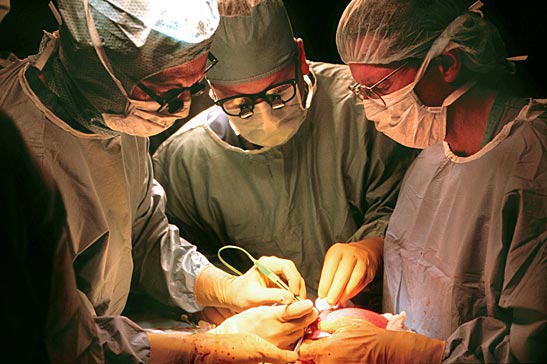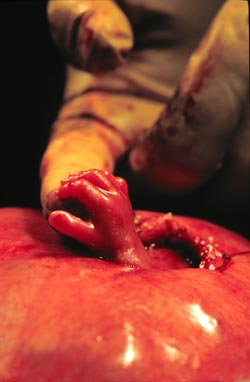Baby Born at Vanderbilt Hospital With Spina Bifida

Results of a landmark, vii-yr National Institutes of Wellness-funded trial, Direction of Myelomeningocele Study (MOMS), demonstrate articulate benefit for babies who undergo fetal surgery to treat spina bifida, the most common birth defect in the fundamental nervous system.
The surgical procedure, in utero repair of myelomeningocele, was pioneered at Vanderbilt University Medical Eye in 1997, with the first procedure performed on Corey Meyer of Mt. Juliet, Tenn., and her unborn son Daniel.
Enrollment in the MOMS trial was halted in December 2010, because researchers at the study's three

trial sites– Vanderbilt, the University of California San Francisco and Children'south Hospital of Philadelphia –plant the procedure demonstrates meaning benefit over the current standard of care, surgical repair after birth.
The findings, published in the February. 9 online result of the New England Journal of Medicine, show babies who have corrective surgery for a serious course of spina bifida (myelomeningocele) while still in the uterus, feel a reduction in potentially life-threatening hydrocephalus and have
an increased power to walk.
"The results are very exciting and confirm what our surgeons and researchers plant back in 1999,"
said John Brock III, surgeon-in-master for the Monroe Carell Jr. Children's Hospital at Vanderbilt, and
principal investigator for the Vanderbilt site of MOMS.
Brock said teams of Vanderbilt experts, led past maternal/fetal surgeon Joseph Bruner, who is no
longer with Vanderbilt, and Noel Tulipan, director of pediatric neurosurgery, pursued research in the early 1990s that led to the first such procedures in the country. The Vanderbilt squad published evidence that the surgery was beneficial in the Journal of the American Medical Association in 1999.
Paralysis, disabilities
Despite nationwide fortification of folic acid, the incidence of myelomeningocele has stabilized to 3.4 per 10,000 births. The layers of tissue and bone that normally comprehend and protect the spinal cord fail to close during development, leaving delicate nerves exposed to the intrauterine environment.
Children are often left with severe disabilities including paralysis below the waist, and lifelong bladder and bowel problems. About 90 per centum of children with this disorder develop hydrocephalus, a fluid build-upwards within the encephalon, which requires surgical placement of a shunt to drain fluid. A shunt, while necessary to relieve a child'southward life, can impact intellectual development.
Landmark trial
The MOMS trial spanned seven years and included 183 participants. Half of the patients were randomized to receive fetal surgery to close their babies' spines between the 19th and 25th week
of gestation.
The study was designed to address the "2-hitting" theory, that in add-on to the damage sustained during development, the nervous system continues to experience impairment from environmental exposure in utero.
The MOMS trial establish fetal surgery reduced the need for a shunt past nigh 30 percent and significantly improved the child's chances of being able to walk. There was no increased risk of death for the babe or the female parent when the fetal surgery group was compared with a group that received surgery after nativity.
Encounter Emily
Earlier MOMS began, Vanderbilt had performed 177 fetal repairs. Maryann Dotegowski was patient No. 19.
"When they found the spina bifida, our specialist hither in New Jersey said if I were his wife, he'd send me to Vanderbilt. We got on a aeroplane every bit soon as we could," Dotegowski recalls.
Today, her daughter, Emily, is an energetic center-schooler who loves to sled. The family has returned to Nashville every year to see Tulipan for surgeries and follow-ups. Dotegowski says while Emily has pregnant physical challenges, she believes her daughter is able to walk because of the fetal surgery.
"Well-nigh every doctor we talked to said she should exist paralyzed from chest down," Dotegowski said.
Overcoming doubts
Although spina bifida is disabling, it is not a lethal disease, and some critics said the risks were too great.
"There were a lot of people who were very much against it because it was possible the intrauterine surgery might impale the baby, or even the mother. Nosotros needed a randomized controlled study," said Tulipan.
William Walsh, professor of pediatrics and director of nurseries at Vanderbilt, was one of the authors of the 1999 JAMA written report, yet he recalls strongly advising parents of the known risks to their babies.
"Information technology is so innovative to open the womb and operate at the limits of viability with the hope of improving a non-fatal illness. This is the first surgery of its kind and nosotros knew there was a 100 percent take chances of prematurity, so we had to be absolutely sure that benefits were greater than the risks," said Walsh.
A family thing
When the trial began in 2003, Vanderbilt's fetal surgery repair rate dropped from well-nigh 2 a week to less than one a month. Families who participated were required to spend the remainder of pregnancy living shut to the study middle. Once the babe was born and discharged from the hospital, the families returned for 12- and 30-month follow-upwards assessments.
Even though participants' expenses were covered, it was daunting.
"It was a tremendous burden to the team that was doing this procedure, because they felt it helped
children. Only proving information technology was going to help it become the standard of care, otherwise the public, and the surgical communities might never have accepted this procedure," Brock said.
Women'southward wellness nurse practitioner, Mary Dabrowiak, ane of the authors of the NEJM study and MOMS Coordinator, enrolled all 52 participants hither at Vanderbilt.
"The families are the true heroes of this study," she said. "Each one said to usa that even if they
ultimately learned the procedure they had was not the near beneficial, they knew they were making the best selection, to assist find the answers. Vii years subsequently, the MOMS families continue their commitment, and the study sites have become a benchmark for spina bifida intendance," Dabrowiak said.
Irresolute the conversation
MOMS showed at that place is risk inherent in the fetal surgery. Babies were generally born at 34 weeks of
gestation, ofttimes requiring a stay in a neonatal intensive care unit for breathing issues linked with prematurity. Mothers who take the procedure must deliver subsequent babies by Caesarian section because of a risk of uterine rupture.
"Because mothers are willing to go to extraordinary lengths to help their babies, and bear significant risks, even to their own health, we needed compelling evidence that the procedure is beneficial and rubber. It is very satisfying to me that, with this new prove, we can modify our dialogue with families and offering the information they need to be able to make an informed determination," said Kelly Bennett, the maternal/fetal specialist who performs the maternal portion of the surgery at Vanderbilt.
The study besides shows further benefits for the baby, including a significant (30 pct) reduction of hindbrain herniation (Chiari malformation) in the patients who accept undergone the fetal surgery – something Vanderbilt researchers as well saw in the 1999 study. Tulipan says he is thrilled his previous findings have been reinforced, particularly the reduction in the demand for shunts.
"Shunts are what bring these patients back to the infirmary over and over once again. When a shunt fails it is a life-threatening situation. That's something these patients walk around with hanging over their head all their lives. It is a huge benefit," Tulipan said.
The report's participants will continue to be followed. Several more questions remain to exist answered. The children delivered during the MOMS trial, some of whom are every bit old as 7, will continue to be assessed to encounter if side effects of myelomeningocele like float and bowel control, and intellectual/learning disorders are impacted by fetal surgery.
The telephone number for information nearly fetal surgery to repair myelomeningocele at Vanderbilt is (877) 875-3737 or in the Nashville expanse (615) 875-4500.
Visit the Vanderbilt website for data on fetal surgery, including the spina bifida repair.
Visit the official MOMS website.
Baby Born at Vanderbilt Hospital With Spina Bifida
Source: https://news.vanderbilt.edu/2011/02/09/vanderbilt-pioneered-fetal-surgery-procedure-yields-positive-results/
0 Response to "Baby Born at Vanderbilt Hospital With Spina Bifida"
Post a Comment